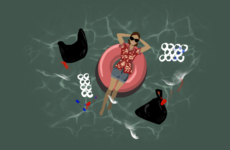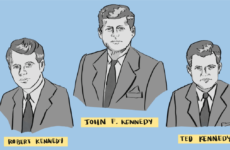
Graphic by Kate Park ’27/The Choate News
By Reinah Lee’26
Would you rather go to a non-Ivy League school and make one million dollars or attend an Ivy League School and incur a debt of $400,000? Unfortunately, this hypothetical scenario has become a real dilemma for some student-athletes.
With the National Collegiate Athletic Association (NCAA) Division I Council implementing new Name, Image, and Likeness (NIL) protections aimed at safeguarding college athletes earlier this year, the controversial debate about compensating college athletes for their play has made a comeback, raising concerns about the Ivy League’s unique take on the matter.
College athletes in NIL-allowed schools were allowed to monetize their name, image, and likeness with brand deals without risking their competitive eligibility. However, each collegiate school has a different stance on NIL — the eight schools that make up the Ivy League remain adamant about keeping a distance from NIL.
The primary objections to NIL commercialization revolve around the concern that it could shift student-athletes’ focus from education to financial gain. Currently, this group of prestigious universities does not provide athletic scholarships to their student-athletes. Priding themselves on their highly selective admissions, Ivy Leagues view sports as a secondary to academics and, in turn, have received pushback on their firm stances.
Since the NCAA enacted NIL, new policies and regulations facilitating athlete transfers have generated a national conversation over the function of NIL collectives in player development and recruitment. Additionally, it has put Ivy Leagues in an unfavorable position because the money players can make in other schools trumps the the elite education Ivies offer. By remaining reluctant to adopt NIL rules, the Ivy League risks losing talent from not only prospective high school athletes but also current stars tempted by the transfer portal. In an interview conducted by The Harvard Crimson, Harvard’s Athletic Director Erin McDermott said she was willing to take the risks of student-athletes transferring to other schools.
Take Harvard Men’s Basketball star Malik O. Mack, named the Ivy League’s rookie of the year, as an example. Mack averaged 17.2 points with an average of 4.8 assists per game, ranked fourth in the Ivy League in scoring, and ranked first in assists. However, Mack did not receive any compensation for his contributions. On the contrary, Duke University freshman guard Jared McCain, who averages less than Mack with 14.3 points and 1.9 assists per game, has a NIL value of a whopping one million dollars.
Through utilizing self-advertisement, McCain has been able to monetize his status as a college athlete and grow his social media, where he currently has 2.8 million TikTok followers. With the opportunity to have similar financial benefits and fame as other college athletes, more Ivy League players are sure to look into transferring. Despite the top-notch education Harvard and the Ivies offer, college athletes like Mack may prioritize the different opportunities offered by NIL that the Ivy League lacks.
Although the Ivy League does not have donor-funded NIL collectives, its students are still trying their hand at profiting from their contributions. For example, Gabby Anderson, a guard on the Women’s Basketball team at Harvard University and Chief Executive Officer of the shoe customization business Graffiti by Gabby, is signed under an NIL deal where she can make money off her athletic and artistic abilities. In July 2023, Harvard Athletics disclosed its adoption of the INFLCR athlete app, enabling student-athletes like Anderson to access media content independently. In contrast, Harvard Track athlete Fabiola Belibi found INFLCR inadequate, explaining the need for more transparency to make NIL opportunities easier to secure. If the Ivy League supports the usage of self-advertisement aids like INFLCR, why do they refuse to implement NIL collectives?
It is evident that NIL is here to stay, and the Ivy League should keep up by forming some sort of collective — even if it is minor or includes restrictions on what Ivy college athletes can and can’t do. From missing out on prospective top talent to losing their very own athletic stars, avoiding NIL prevents Ivy League Athletics from reaching their full potential and will possibly cause detriment to the league in the future.




